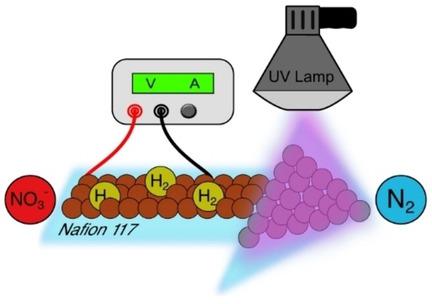当前位置:
X-MOL 学术
›
ChemSusChem
›
论文详情
Our official English website, www.x-mol.net, welcomes your
feedback! (Note: you will need to create a separate account there.)
PEM Electrolysis‐Assisted Catalysis Combined with Photocatalytic Oxidation towards Complete Abatement of Nitrogen‐Containing Contaminants in Water
ChemSusChem ( IF 7.5 ) Pub Date : 2020-12-30 , DOI: 10.1002/cssc.202002828 Jordi Ampurdanés 1 , Sorin Bunea 2 , Atsushi Urakawa 1, 2
ChemSusChem ( IF 7.5 ) Pub Date : 2020-12-30 , DOI: 10.1002/cssc.202002828 Jordi Ampurdanés 1 , Sorin Bunea 2 , Atsushi Urakawa 1, 2
Affiliation

|
Electrolysis‐assisted nitrate (NO3−) reduction is a promising approach for its conversion to harmless N2 from waste, ground, and drinking water due to the possible process simplicity by in‐situ generation of H2/H/H+ by water electrolysis and to the flexibility given by tunable redox potential of electrodes. This work explores the use of a polymer electrolyte membrane (PEM) electrochemical cell for electrolysis‐assisted nitrate reduction using SnO2‐supported metals as the active cathode catalysts. Effects of operation modes and catalyst materials on nitrate conversion and product selectivity were studied. The major challenge of product selectivity, namely complete suppression of nitrite (NO2−) and ammonium (NH4+) ion formation, was tackled by combining with simultaneous photocatalytic oxidation to drive the overall reaction towards N2 formation.
中文翻译:

PEM电解辅助催化结合光催化氧化可完全消除水中的含氮污染物
电解辅助硝酸盐(NO 3 - )还原为其转化为无害的N A有前途的方法2从废物,地面,和饮用水由于可能工艺简化通过原位产生h的2 / H / H +通过水电解以及电极可调节的氧化还原电位所提供的灵活性。这项工作探索了使用高分子电解质膜(PEM)电化学电池进行电解辅助硝酸盐还原的方法,该方法使用SnO 2负载金属作为活性阴极催化剂。研究了操作方式和催化剂材料对硝酸盐转化率和产物选择性的影响。产品选择性的主要挑战,即完全抑制亚硝酸盐(NO2 - )和铵(NH 4 +)离子的形成,通过用同步光催化氧化相结合来驱动朝向n中的总反应攻克2形成。
更新日期:2020-12-30
中文翻译:

PEM电解辅助催化结合光催化氧化可完全消除水中的含氮污染物
电解辅助硝酸盐(NO 3 - )还原为其转化为无害的N A有前途的方法2从废物,地面,和饮用水由于可能工艺简化通过原位产生h的2 / H / H +通过水电解以及电极可调节的氧化还原电位所提供的灵活性。这项工作探索了使用高分子电解质膜(PEM)电化学电池进行电解辅助硝酸盐还原的方法,该方法使用SnO 2负载金属作为活性阴极催化剂。研究了操作方式和催化剂材料对硝酸盐转化率和产物选择性的影响。产品选择性的主要挑战,即完全抑制亚硝酸盐(NO2 - )和铵(NH 4 +)离子的形成,通过用同步光催化氧化相结合来驱动朝向n中的总反应攻克2形成。











































 京公网安备 11010802027423号
京公网安备 11010802027423号